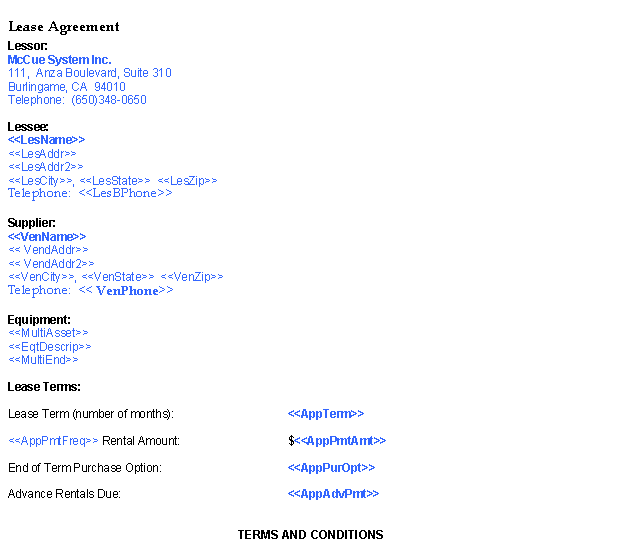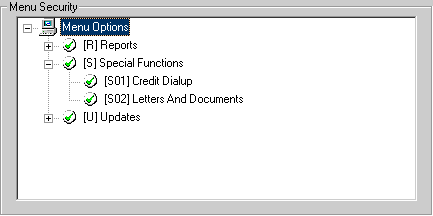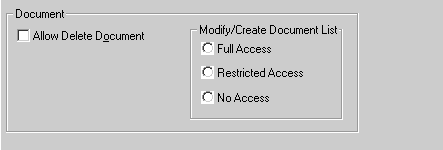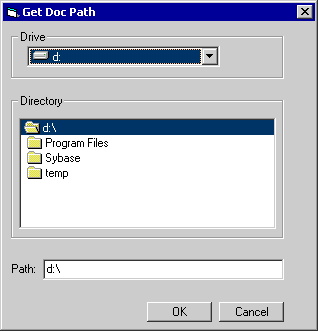Document Generation
Contents
Introduction
The Automated Document Generation module works in conjunction with LeasePak's Base System and the Application Tracking [U0801] module. The Automated Document dx Generation module allows the user to produce documents directly from their PC. Documents including Master Lease Agreements, Lease Schedules, Pricing Quotes, Invoices, Payoff Quotes, Collection and Customer Service Letters can be generated using a mail merge type function setup between Microsoft Word and LeasePak. For more on dx Generation, refer to the document dx Generation.
The module may be accessed through any of the Tracking Modules in LeasePak, Collections, Customer Service, Insurance, Mature Lease, Recovery modules as well as via the LeasePak Task Bar. Once the Task Bar is activated, the List of allowable (see Template set-up) documents is displayed for the user to select and complete the merge of actual data to produce the selected Document.
Additionally, this module enhances the Document List update [U0815] and allows the user to specify the document to generate based on status and the associated Word template used for the merge. By creating Document Lists to match the specific type of business, a Document list for each Lease Form for example, the User can ensure the correct and most up-to-date Documents are being produced.
The Word templates must be predefined and will contain both static text as well as mail merge 'fields' that are then replaced automatically with actual data from the application, lease or payoff quote etc., that the user is working with at the time. The merged document may be opened in Word as a *.doc file which can then be printed, faxed, email, converted to a PDF file, etc. Please see the Document List [U0815] update for a complete list of the fields currently supported.
Word must be installed on the client computer of the user.
This module also works in conjunction with the dx Generation module and scheduler. The interface allows various document types, including letters and invoices, to be created automatically. The user can define task(s) and schedule the time a task(s) will be automatically processed. A scheduled task will connect to LeasePak's database and execute the SQL for each defined primary key(s), such as the Lease #; calling the appropriate DLL template and merge the data to generate the scheduled document to be saved or printed based on the task definition.
Sample Document Templates
You can find sample document templates in the docsuite/refguide/general/doc_gen/samples folder. These files are Word template files (*.dot).
Template Setup
Use Microsoft Word to create and save documents as templates files. The Application template name must be defined as: A*.dot,and must not exceed a maximum of 20 characters; the naming convention is not case sensitive.
The users PC, depending on the users Security [U0706] settings, must be able to access the template directory defined in the Application Portfolio [U0822] update. LeasePak will then create the document(s) and replace the pre-defined key words in the template with the field values from LeasePak's database. For a detailed list of key values, refer to the Valid Key Values table found in this document.
Currently this enhancement only supports Word document templates.
Key words and the table fields are stored in LeasePak and may be modified by the user and an MSI representative only. Currently LeasePak supports the following tables:
| rsc | Security |
| ral | Lessee |
| rlr | Vendor |
| rbk | Broker |
| rin | Investor |
| rcu | Customer |
| rfl | Group |
| rls (child and overflow table) | Lease |
| rap (child and overflow table) | Application |
| raq (child and overflow table) | Pending Asset |
| req (child and overflow table) | Book Asset |
| rpa | Portfolio |
| rpd | Payoff Quote |
| rar (and child table) | Account Receivable |
| rdm | Demography |
| rdmi | Insurance |
| rgc | Guarantor, Co-Lessee and user defined client* |
| rna | Remittance address The RNA table is used for multiple purposes; therefore, the user must use RNA8 as the table name in the document. |
| rua | User Defined Asset Fields |
| rubt | User Defined Asset Table |
| rud | User Defined Customer Fields |
| ruet | User Defined Customer Table |
| rug | User Defined Lease Fields |
| ruht | User Defined Lease Table |
| ruj | User Defined Application Fields |
| rukt | User Defined Application Table |
| rum | User Defined Lessee Fields |
| runt | User Defined Lessee Table |
| ruo | User Defined Vendor Fields |
| ruqt | User Defined Vendor Table |
| rur | User Defined Application Asset Fields |
| rust | User Defined Application Asset Table |
If keywords are user defined, certain rules apply in order to setup the key words. The first three characters of the key word must represent the table name:
- Application fields, the first three characters must be App
- Lessee fields, the first three characters must be Les
- Vendor fields, the first three characters must be Ven
- Asset fields (raq/req), the first three characters must be Eqt
The key word values listed in the table below, must be defined within << >>; for example, <<LesNum>>. See sample Lease Agreement for more examples.
In order to define multiple records, for example Assets and Payment Schedules, additional key words must be defined in the Template to retrieve multiple items. If the multiple key words are not established within the template, LeasePak will only retrieve the value from the first record.
Each multiple key word must start on a new line. The following are valid multi-key words:
- <<MultiPedAsset>>
- <<MultiBokAsset>>
- <<MultiSchedule>>
- <<MultiEnd>>
Example
In the Lease Agreement example below, only the first Asset description will be retrieved.
- Equipment
- <<MultiAsset>>
- <<EquipDesc>>
- <<MultiEnd>>
To retrieve Pending (Assets not yet Booked) Asset Descriptions associated with the Application, the following values should be defined in the template:
- Equipment
- <<MultiPedAsset>>
- <<EquipDesc>>
- <<MultiEnd>>
To retrieve the description of all the Assets (both Pending and Booked), the following values should be defined in the template:
- Equipment
- <<MultiPedAsset>>
- <<EquipDesc>>
- <<MultiEnd>>
- <<MultiBokAsset>>
- <<EquipDesc>>
- <<MultiEnd>>

This screen is a sample document template.
In some cases, a special table name is assigned, RGCL-Co-Lessee, RGCG- Guarantor, RGCU- User Defined Client. The field may physically reside in the RCX-Cross Ref, or RAL (Lessee), or the RGR Guarantor table.
LeasePak will map to the actual table to retrieve the data. Since multiple records exist, multi-tags need to be used. For example, Guarantor is shown below:
<<Multi>> <<rgcl.les_s>> <<rgcl.nam_long_s>> <<rgcl.ss_s>> <<MultiEnd>>
Other clients like Vendor, Lessee, etc, the DBA Name and Social Security Number is stored in RCX table, and the following rules must be applied in order to retrieve the data.
To retrieve SSN / Tax ID
- Use original client table
- Use new virtual column ss_s
Example:
<<ral.ss_s>> for lessee or <<rlr.ss_s>> for vendor.
To retrieve DBA name
- Use original client field table
- Use new virtual column dba_name_s
Example:
<<ral.dba_name_s>>
Multi row parameters support RAQ, REQ and RAR and the Payment Schedule in RLS or RAP tables. An additional tag is required to identify that the data has multiple records. For example:
RAQ tag:
<<MultiPedAsset>>...<<MultiEnd>>
REQ tag
<<MultiBokAsset>>...<<MultiEnd>>
RLS or RAP Tag for payment schedule
<<MultiSchedule>>...<<MultiEnd>>
RAR tag
<<MultiInvoice>>...<<MultiEnd>>
In some cases <<Multi>>...<<MultiEnd>> will work for any section where the user expects multiple records.
All key word mappings are stored in RDG table; the default set does not contain the entire table or field names. However, you can add a new record to the table. If the key word is in the format of the table name and field e.g <<rls.lse_s>>, the program will recognize the new record, without adding it to the RDG table.
For an invoice, special key words needed and recognized but will not add the key word to RDG table:
- Outstanding Payment Amount: <<Pamt>>
- Outstanding Interest Amount: <<Iamt>>
- Outstanding Assessment Amount: <<Aamt>>
- Total Outstanding Payment Amt of all the invoices in the lease: <<TotPamt>>
- Total Outstanding Int Amt of all the invoices in the lease: <<TotIamt>>
- Total Outstanding Assessment Amt of all the invoices in lease: <<TotAamt>>
- Total Outstanding Amt of all the invoices in lease: <<TotAmt>>
Special hard coded key words for invoice:
- Outstanding Payment Amount: <<Pamt>>
- Outstanding Interest Amount: <<Iamt>>
- Outstanding Assessment Amount: <<Aamt>>
- Total Outstanding Payment Amt of all the invoices in the lease: <<TotPamt>>
- Total Outstanding Int Amt of all the invoices in the lease: <<TotIamt>>
- Total Outstanding Assessment Amt of all the invoices in lease: <<TotAamt>>
- Total Outstanding Amt of all the invoices in lease: <<TotAmt>>
Field level formatting codes is handled and supported by placing a slash ( / ) after a key word. For example, the field for American Phone Number format:
<<ral.bus_phn_s/phn>>
The following format codes are supported:
| US phone format (###)###-#### | phn |
| US dollar currency, put $ in front, will not display if it is 0 | cur |
| US dollar currency, put $ in front, display even it is 0 | cur0 |
| Percentage, 7 digits after decimal, no display if 0 | per |
| Percentage, 2 digits after decimal, no display if 0 | per2 |
| Percentage, 5 digits after decimal, no display if 0 | per5 |
| Percentage, 7 digits after decimal, display if 0 | per0 |
| Percentage, 2 digits after decimal, display if 0 | per20 |
| Percentage, 5 digits after decimal, display if 0 | per50 |
| social security number | ###-##-#### |
| any string after slash, it will used as mask for formatting | any |
The following are not currently supported in DocGen:
- Calculated fields such as req.org_d - req.res_d
- If multiple records are expected, Doc Gen will not able to retrieve a specific record. For example: if the user wants to display all the late charges on assessments without the sales tax, all assessments will be displayed
- Using key words from tables with multiple records.
DocGen Objects
DocGen contains two object, MSIDocGD.dll and MSIDocGM.dll
MSIDocGD.dll
The Document Data Generating object, generates the data for the document and creates an XML file. The objects interfaces are as follows:
| TemplatePath | Template Path + Document Template Name |
| UserName | Database User Name |
| Password | Database Password |
| Database | Database Name |
| ODBCSource | ODBC Source Name |
| DocKeyType | 1 for application, 2 for Lease, 3 for invoice, 4 for Lessee |
| DocKey | Application number, Lease number, Invoice number or Lessee Number. |
| ErrorMsg | return error message, blank if no error |
| Version | Version of Object |
MSIDocGM.dll
The Document Data Merged object, it merged the data with the document and creates an XML file. The objects interfaces are as follows:
| TemplatePath | Template Path + Document Template Name |
| DocumentPath | Document Path |
| PurgeDoc | True or False purge document or not |
| PrintDoc | True or False print document or not |
| XMLDataFile | Path + data XML filename |
| DocumentFile | Path + Final Document filename. |
| ErrorMsg | return error message, blank if no error |
| Version | Version of the object |
Header and Footer Sections
DocGen now supports fields in the document template header and footer sections.
Valid Key Values
The table below lists the key words, database field format and descriptions needed to define the document templates. The database field format for the key word values is: table_name.field_name
Note: The key word values listed in the table below, must be defined within << >> for example, << LesNum>>. Due to HTML formatting within the Reference Guide, the symbols (<< >>) have been omitted within the table.
| Table | Key Word | Database Field | Description |
| RAL | <lesnum>LesNum | ral.les_s | Lessee number |
| LesName | ral.nam_long_s | Lessee long name | |
| LesAddr | ral.add_s | Lessee address line 1 | |
| LesAddr2 | ral.add2_s | Lessee address line 2 | |
| LesCity | ral.cty_s | Lessee city | |
| LessState | ral.st_s | Lessee state | |
| LesZip | ral.zip_s | Lessee zip code | |
| LesBPhone | ral.bus_phn_s | Lessee business phone | |
| LesHPhone | ral.hom_phn_s | Lessee home phone | |
| LesContact | ral.short_cont_nam_s | Lessee contact name | |
| LesContTitle | ral.cont_title_s | Lessee contact title | |
| LesBillName | ral.bill_nam_s | Lessee bill name | |
| LesBillAddr | ral. bill_add_s | Lessee bill address line 1 | |
| LesBillAddr2 | ral. bill_add2_s | Lessee bill address line 2 | |
| LesBillCity | ral. bill_cty_s | Lessee bill city | |
| LesBillState | ral. bill_st_s | Lessee bill state | |
| LesBillZip | ral. bill_zip_s | Lessee bill zip code | |
| VenNum | rlr.dlr_s | Vendor number | |
| RLR | VenName | rlr.nam_long_s | Vendor long name |
| VenAddr | rlr.add_s | Vendor address line 1 | |
| VenAddr2 | rlr.add2_s | Vendor address line 2 | |
| VenCity | rlr.cty_s | Vendor city | |
| VenState | rlr.st_s | Vendor state | |
| VenZip | rlr.zip_s | Vendor zip code | |
| VenPhone | rlr.phn_s | Vendor phone | |
| PedEqtNum | raq.unit_s | Pending Asset number | |
| RAQ | PedEqtID | raq.id_s | Pending Asset identification |
| PedEqtDesc | raq.desc_s | Pending Asset description | |
| PedEqtServ | raq.d_serv_s | Pending Asset in service date | |
| PedEqtCost | raq.org_d | Pending Asset original cost | |
| PedEqtRes | raq.res_d | Pending Asset residual Amount | |
| PedEqtAddr | raq.eq_add_s | Pending Asset address | |
| PedEqtCity | raq.eq_cty_s | Pending Asset city | |
| PedEqtState | raq.eq_st_s | Pending Asset state | |
| PedEqtZip | raq.eq_zip_s | Pending Asset zip code | |
| PedEqtPurOrd | raq.pur_ord_s | Pending Asset purchase order number | |
| REQ | BokEqtNum | req.unit_s | Book Asset number |
| BokEqtID | req.id_s | Book Asset identification | |
| BokEqtDesc | req.desc_s | Book Asset description | |
| BokEqtServ | req.d_serv_s | Book Asset in service date | |
| BokEqtCost | req.org_d | Book Asset original cost | |
| BokEqtRes | req.res_d | Book Asset residual Amount | |
| BokEqtAddr | req.eq_add_s | Book Asset address | |
| BokEqtCity | req.eq_cty_s | Book Asset city | |
| BokEqtState | req.eq_st_s | Book Asset state | |
| BokEqtZip | req.eq_zip_s | Book Asset zip code | |
| BokEqtPurOrd | req.pur_ord_s | Book Asset purchase order number | |
| AppNo | rap.app_s | Application number | |
| RAP | AppTerm | rap.trm_l | Application Term |
| AppComm | rap.d_com_s | Application Commencement date | |
| AppLsd | rap.d_lsd_s | Application lease date | |
| AppPurOpt | rap.pur_opt_s | Application purchase option | |
| RNM | NamBankName | rnm.name_s | Application bank name |
| RAP | AppYield | rap.p_con_d | Application Yield |
| AppRate | rap.p_rent_d | Application simple rate or add-on | |
| AppCost | rap.tot_org_d | Application total cost | |
| AppRes | rap.tot_res_d | Application residual amount | |
| AppSec | rap.sec_d | Application Security Deposit | |
| AppDn | rap.cap_d | Application down payment | |
| AppInterim | rap.up_d | Application Interim rent | |
| AppAdvPmt | rapp.pmt_amt_d[0] | Application advance payment | |
| RAPP | AppPmtAmt | rapp.pmt_amt_d | Application payment amount |
| AppPmtFrq | rapp.pmt_frq_l | Application payment frequency | |
| AppPmtCode | rapp.pmt_cd_s | Application payment code | |
| AppNextDueDate | Calculated - first | Next due date, application book invoice with due date after commenced date | |
| RSC | UsrBooking | rsc.name_s | Operator Name |
LeasePak Setup
When the Automatic Document Generation module is purchase, various controls settings within LeasePak's updates must be established prior to initiating the Document Generation functions. Below are the updates and fields that work in conjunction with this module. For additional information on these updates and fields, please refer to the specified update and/or field document within the Reference Guide.
Security [U0706]
The Automated Lease Document Generation module user security access is established in the Security [U0706] update. The Letters And Documents [S02] option in Special Functions menu, allows the user to setup, access and generate documents when the Document Generation Letters and Documents [S02] security is granted.
When security is not granted, the user cannot generate Documents and Tasks from the Document Generation option or Delete File Attachments. The user does have the ability to setup and delete Documents and Tasks to be processed. Additionally, the user may only view, open and edit previously generated File Attachments.

Application User Profile [U0831]
The users Document profile settings must be established in order to define user accessibility to the Document List [U0815] update.

The Letters/Docs 3, tab of the Application User Profile [U0831] update requires the the Document portion of the screen to be defined for user access to the Document List [U0815] update. Select the desired options for the users profile.
-
ALLOW DELTE DOCUMENT
Select this option to allow the user to delete documents (lists, generated, attachments).The default value is unchecked, user does not have ability to delete documents.
-
MODIFY/CREATE DOCUMENT LIST
Select the desired access level for the user's profile. The default value is unchecked, user does not have ability to modify or create a document list.- Full Access allows the user the ability to modify, create and add a document list.
- Restricted Access allows the user to add and change a document list, but cannot modify the default list
- No Access restricts the users access to the document list completely.
Application Portfolio [U0822]
The Document Follow-up Days, Template Location and Document Location in the Application Portfolio [U0822] must be defined. For more detailed information, refer to the Application Portfolio [U0822] update.

The following fields work in conjunction with the Document List [U0815] update.
- DEFAULT
DOCUMENT AUTO NOTE FOLLOW-UP DAYS
Enter the default number of days to automatically follow-up on generated document notes.
- TEMPLATE LOCATION
Enter or browse for the default template location. The location defines where all document list templates will be stored. Select the directory path.
- DOCUMENT LOCATION
Enter or browse for the default document location. The location defines where all documents will be be stored once a list is generated. Select the directory path.
This screen displays the documents drive, directory and path location.
Document List [U0815]
The document template must be associated with the Document Name in the list.

This screen is used to enter a document list description and documents that are to be associated with the code. For each document, the supervisor can also specify when the document is required by entering an Application Status, as defined by the Application Status update [U0811]. The document will then be required when an application is changed to this status. Refer to Status Transfer of the Application update [U0801] for more information.
- DOCUMENT LIST DESCRIPTION
Add or modify the description of the Document List Code.
- DOCUMENT NAME (scrolled area)
Enter the names of documents to be included in this list. At least one document must be entered. Up to 50 documents may be entered.
- REQUIRED STATUS (scrolled
area)
Enter an Application Status, as defined by Application Status update [U0811], to indicate when the document will be required. Before an application with this Document List Code is changed to this status, receipt of the document will be required . If the field is left blank (None), the document will not be required. Refer to the Document List option of the Application update [U0801] for more information. Use Help for a list of valid status codes.
- DOC
TEMPLATE
Select the desired template name to be associated with the document name from the drop down directory. The template name must be MS Word template format, a**.dot; and may not contain more than 20 characters in the name; it is not case sensitive.
If (NONE) is selected, no document(s) will be generated. If (MANUAL) is selected, Leasepak will update the DATE CREATED field without generating the document.
LeasePak Reference Guide
©
by McCue Systems Incorporated. All rights reserved.
The information contained in this document is the property of McCue Systems, Inc. Use of the information contained herein is restricted. Conditions of use are subject to change without notice. McCue Systems, Inc. assumes no liability for any inaccuracy that may appear in this document; the contents of this document do not constitute a promise or warranty. The software described in this document is furnished under license and may be used or copied only in accordance with the terms of said license. Unauthorized use, alteration, or reproduction of this document without the written consent of McCue Systems, Inc. is prohibited.